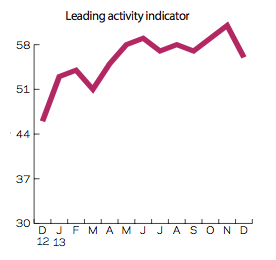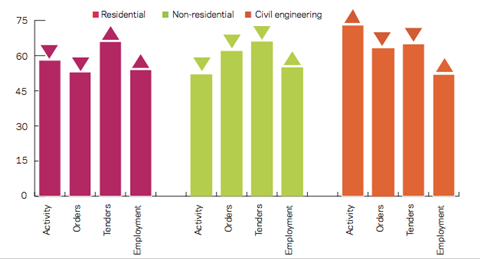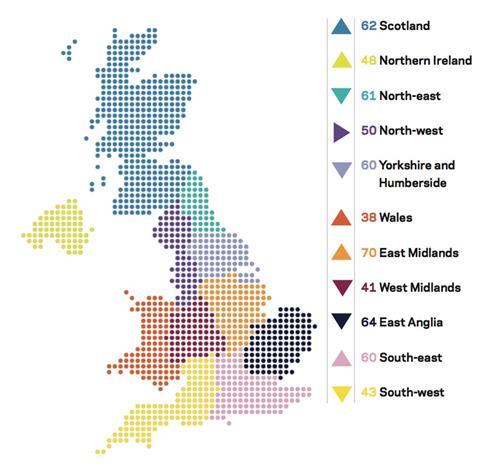Indices for activity, orders and enquiries are all still in positive territory, but the growing problem of material and equipment shortages needs keeping an eye on
01/ STATE OF PLAY
The construction activity index edged downward by one point in September to 57, remaining in positive territory for the ninth straight month. Activity picked up sharply in the civil engineering sector reaching 73, a monthly increase of 14 points. Conversely, both the residential and non-residential sectors saw a fall in activity, the former by one point to 58, while the latter saw an eight-point decline to 52.
The orders index fell to 56, down four points on the previous month; this was the sixth straight month of above-average orders for this time of year. Tender enquiries reached 64 last month, up 13 points annually.
The percentage of respondents indicating that they were experiencing no constraints on activity rose slightly to 27%. The proportion indicating that insufficient demand was restricting activity increased to 48%, the most significant constraint to activity. Labour shortages became a less prominent factor in September at 4%, which was half August’s figure, while the proportion indicating that financial concerns were hampering activity remained at 16%. Bad weather was of negligible concern to firms, as only 1% of respondents indicated it as a concerning factor, although this is likely to increase over the winter months. Some 3% of respondents felt material and equipment shortages was affecting their activity levels, the highest proportion on our records.
The employment prospects index gained six points to reach 54, taking it back above the no-change mark of 50. This is also the highest level recorded since December 2007. This indicates that businesses expect employment levels to increase over the coming three months.
The tender prices index reached 59 in September, up two points on the previous month and reaching the highest index since March 2008.
02/ LEADING CONSTRUCTION ACTIVITY INDICATOR



CFR’s Leading Construction Activity Indicator fell by one point to total 57 in September, up seven points on an annual basis. The index is predicted to gain two points this month, before ticking up to 61 in November.
The indicator uses a base level of 50: an index above that level indicates an increase in activity, below that level a decrease.

03/ WORK IN HAND

In September 2013, the majority of firms across all three sectors reported having less than three months’ work-in-hand, with only 19% of civil engineering respondents indicating that they had three months or more - down seven percentage points from three months ago. The largest change was also observed in the civil engineering sector, as those businesses indicating that they had over six months’ work-in-hand fell by 6% to 5%. While the percentage reporting they had less than three months increased by six percentage points to 81%.
04/ REGIONAL PERSPECTIVES

Experian’s regional composite indices incorporate current activity levels, the state of order books and the number of tender enquiries received by contractors to provide a measure of the relative strength of each regional industry.
Five of the 11 regions and devolved nations saw a decrease in their indices. East Anglia and the South-west each fell by six points. However, East Anglia’s index remained in positive territory at 64 whereas the South-west declined to 43. The North-east (61) and Yorkshire and Humberside (60) both saw a two-point decrease in their indices. Elsewhere, the West Midlands’ index declined by three points, reaching 41, while the North-west remained unchanged at 50 points.
The largest uptick was seen by the East Midlands as its index climbed by six points to reach 70, the highest ever recorded by this region. Although Wales experienced a four-point uptick, it remained firmly in negative territory at 38. Northern Ireland’s index edged upwards for the fifth straight month, though remained in negative territory. The South-east and Scotland also saw increases by two and three points respectively.
As a whole the UK index, which includes firms working in 5 or more regions saw its index fall, albeit by one point to 58.
This an extract from the monthly Focus survey of construction activity undertaken by Experian Economics on behalf of the European commission as part of its suite of harmonised EU business surveys.
The full survey results and further information on Experian Economics’ forecasts and services can be obtained by calling 0207-746 8217 or logging on to www.experian.co.uk/economics
The survey is conducted monthly among 800 firms throughout the UK and the analysis is broken down by size of firm, sector of the industry and region. The results are weighted to reflect the size of respondents. As well as the results published in this extract, all of the monthly topics are available by sector, region and size of firm. In addition, quarterly questions seek information on materials costs, labour costs and work-in-hand.






No comments yet